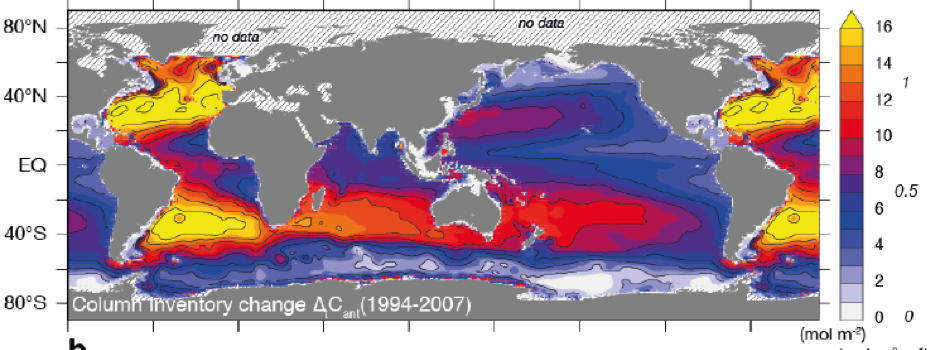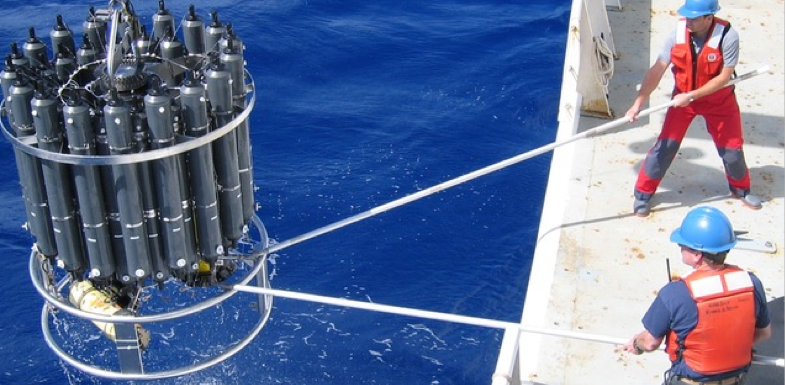Based on article from ETH.
Not all of the CO2 generated during the combustion of fossil fuels remains in the atmosphere and contributes to global warming. The ocean and the ecosystems on land take up considerable quantities of these man-made CO₂ emissions from the atmosphere.
Determining what share of the man-made CO2 emissions the oceans absorb has long been a priority for climate researchers. Using a global set of observations, an international team of scientists led by Nicolas Gruber at ETH Zurich, has now determined this oceanic sink over a period of 13 years.
As reported in the latest issue of Science, the researchers have found that the ocean has taken up from the atmosphere as much as 34 gigatonnes (billions of metric tonnes) of carbon from man-made CO2 between 1994 and 2007. This corresponds to 31 per cent of all anthropogenic CO2 emitted during that time.
“Seeing how tightly the distribution of anthropogenic CO2 is related to the ventilation of the ocean has made this work especially interesting”, says Are Olsen from the Bjerknes Centre and the Geophysical Institute at the University of Bergen.
Together with Siv Lauvset, from the same institutions and NORCE, he has worked specifically on analyzing observational data for the study.
Carbon sinks in the ocean
The ocean takes up CO2 in two steps: first, the CO2 dissolves in the surface water. Afterwards, the ocean’s overturning circulation distributes it: ocean currents and mixing processes transport the dissolved CO2 from the surface deep into the ocean’s interior, where it accumulates over time.
This overturning circulation is the driving force behind the oceanic sink for CO2. The size of this sink is very important for atmospheric CO2: without this sink, the concentration of CO2 in our atmosphere and the extent of anthropogenic climate change would be considerably higher.
The marine sink is intact
The percentage of CO2 taken up by the oceans has remained relatively stable compared to the preceding 200 years, but the absolute quantity has increased substantially. This is because as long as the atmospheric concentration of CO2 rises, the oceanic sink strengthens more or less proportionally: the more CO2 is in the atmosphere, the more is absorbed by the oceans.
So far, that point has not been reached. “Over the examined period, the global ocean continued to take up anthropogenic CO2 at a rate that is congruent with the increase of atmospheric CO2”, Nicholas Gruber explains.
These data-based research findings also confirm various earlier, model-based estimates of the ocean sink for man-made CO2. The results further allow the researchers to draw conclusions about the CO2 sink of the ecosystems on land, which are more difficult to determine.

Results of two surveys
The results are based on data synthesized by the Global Ocean Data Analysis Project (GLODAP) – a global survey of CO2 and other chemical and physical properties in the various oceans, measured from the surface down to depths of up to 6 kilometres.
“The use of these data demonstrates the value of the quality control we have performed on the observations”, says Siv Lauvset. “Work on such large data products is extremely important».
Scientists from 7 countries participated in the internationally coordinated programme that started in 2003. Globally they carried out more than 50 research cruises up to 2013, which were then synthesized into a global data product.
To determine the increase in the oceanic CO2 content as a result of the oceanic uptake of man-made CO2 from the atmosphere, they contrasted the measured CO2 concentration from this new survey to the observations obtained from the first global CO2 survey that was conducted between the late 1980s and the mid 1990s.
Regional differences
While the overall results suggest an intact ocean sink for man-made CO2, in the different ocean basins the researchers discovered considerable deviations from the uptake expected from the rise in atmospheric CO2.
The North Atlantic Ocean, for instance, absorbed 20 per cent less CO2 than expected between 1994 and 2007, likely related to a slowdown of the North Atlantic Meridional Overturning Circulation in the late 1990s.
“The distribution of anthropogenic CO2 is tightly linked to the ventilation of the ocean, that is to how water having absorbed CO2 is brought from the surface to the deep ocean”, explains Are Olsen. “Unless we manage to limit climate change, this ventilation will decrease. Our results show clearly that this will have major consequences for the uptake of CO2 by the ocean.”
Between 1994 and 2007, the lower sink in the North Atlantic was offset by a considerably larger uptake in the South Atlantic, so that the uptake by the entire Atlantic developed as expected.
The researchers documented similar fluctuations in the Southern Ocean, in the Pacific and in the Indian Ocean.
Increasing CO2 content acidifies marine habitats
By moderating the rate of global warming, the oceanic sink for man-made CO2 provides an important service for humanity, but it has its price: the CO2 dissolved in the ocean acidifies the water.
“Our data has shown that this acidification reaches deep into the ocean’s interior, extending in part to depths of more than 3000 m,” Gruber says.
This can have serious consequences for many marine organisms. Calcium carbonate spontaneously dissolves in acidic environments, which poses a hazard to mussels and corals whose shells and skeletons are made of calcium carbonate. The changing chemical composition of the ocean can also impact physiological processes such as the breathing of fish.

Reference
Nicolas Gruber, Dominic Clement, Brendan R. Carter, Richard A. Feely, Steven van Heuven, Mario Hoppema, Masao Ishii6, Robert M. Key, Alex Kozyr, Siv K. Lauvset, Claire Lo Monaco, Jeremy T. Mathis, Akihiko Murata, Are Olsen, Fiz F. Perez, Christopher L. Sabine, Toste Tanhua, Rik Wanninkhof: The oceanic sink for anthropogenic CO2 from 1994 to 2007. Science (2019).
Contact information
Are Olsen (are.olsen@uib.no)
Siv Lauvset (siv.lauvset@norceresearch.no)
Nicolas Gruber (nicolas.gruber@env.ethz.ch)

